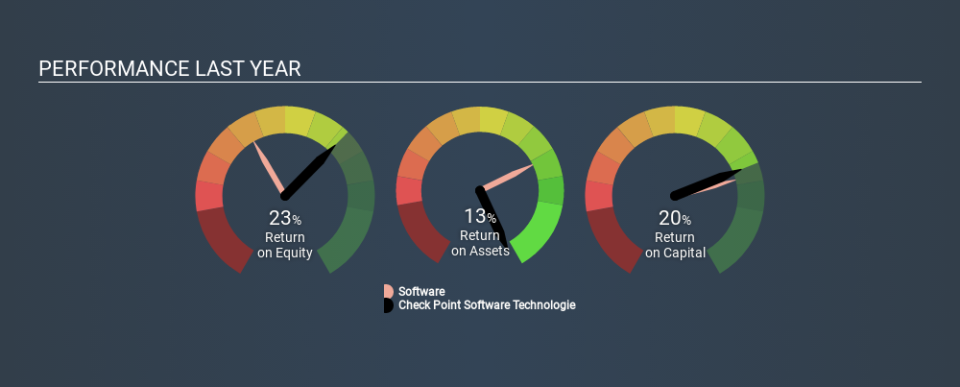Check Point Software Technologies Ltd. (NASDAQ:CHKP) Earns Among The Best Returns In Its Industry

Today we are going to look at Check Point Software Technologies Ltd. (NASDAQ:CHKP) to see whether it might be an attractive investment prospect. Specifically, we're going to calculate its Return On Capital Employed (ROCE), in the hopes of getting some insight into the business.
First of all, we'll work out how to calculate ROCE. Second, we'll look at its ROCE compared to similar companies. Last but not least, we'll look at what impact its current liabilities have on its ROCE.
Return On Capital Employed (ROCE): What is it?
ROCE is a measure of a company's yearly pre-tax profit (its return), relative to the capital employed in the business. In general, businesses with a higher ROCE are usually better quality. Ultimately, it is a useful but imperfect metric. Author Edwin Whiting says to be careful when comparing the ROCE of different businesses, since 'No two businesses are exactly alike.
How Do You Calculate Return On Capital Employed?
Analysts use this formula to calculate return on capital employed:
Return on Capital Employed = Earnings Before Interest and Tax (EBIT) ÷ (Total Assets - Current Liabilities)
Or for Check Point Software Technologies:
0.20 = US$882m ÷ (US$5.8b - US$1.4b) (Based on the trailing twelve months to December 2019.)
So, Check Point Software Technologies has an ROCE of 20%.
View our latest analysis for Check Point Software Technologies
Is Check Point Software Technologies's ROCE Good?
One way to assess ROCE is to compare similar companies. Check Point Software Technologies's ROCE appears to be substantially greater than the 9.6% average in the Software industry. I think that's good to see, since it implies the company is better than other companies at making the most of its capital. Putting aside its position relative to its industry for now, in absolute terms, Check Point Software Technologies's ROCE is currently very good.
You can see in the image below how Check Point Software Technologies's ROCE compares to its industry. Click to see more on past growth.
When considering this metric, keep in mind that it is backwards looking, and not necessarily predictive. ROCE can be deceptive for cyclical businesses, as returns can look incredible in boom times, and terribly low in downturns. ROCE is, after all, simply a snap shot of a single year. What happens in the future is pretty important for investors, so we have prepared a free report on analyst forecasts for Check Point Software Technologies.
Do Check Point Software Technologies's Current Liabilities Skew Its ROCE?
Current liabilities include invoices, such as supplier payments, short-term debt, or a tax bill, that need to be paid within 12 months. Due to the way ROCE is calculated, a high level of current liabilities makes a company look as though it has less capital employed, and thus can (sometimes unfairly) boost the ROCE. To counter this, investors can check if a company has high current liabilities relative to total assets.
Check Point Software Technologies has current liabilities of US$1.4b and total assets of US$5.8b. Therefore its current liabilities are equivalent to approximately 24% of its total assets. A minimal amount of current liabilities limits the impact on ROCE.
What We Can Learn From Check Point Software Technologies's ROCE
, Check Point Software Technologies looks strong on this analysis, but there are plenty of other companies that could be a good opportunity . Here is a free list of companies growing earnings rapidly.
If you are like me, then you will not want to miss this free list of growing companies that insiders are buying.
If you spot an error that warrants correction, please contact the editor at editorial-team@simplywallst.com. This article by Simply Wall St is general in nature. It does not constitute a recommendation to buy or sell any stock, and does not take account of your objectives, or your financial situation. Simply Wall St has no position in the stocks mentioned.
We aim to bring you long-term focused research analysis driven by fundamental data. Note that our analysis may not factor in the latest price-sensitive company announcements or qualitative material. Thank you for reading.

 Yahoo Finance
Yahoo Finance 
